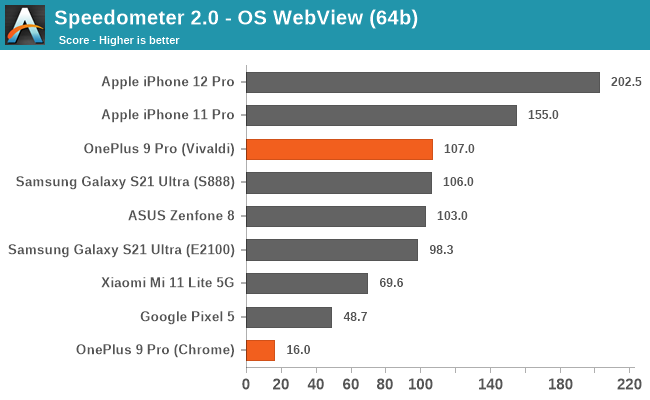The report comes from Anandtech, which cites unusually low benchmark scores on the OnePlus 9 Pro. During the review process, Andrei Frumusanu from the publication discovered that OnePlus is preventing a list of popular Android apps from using the fastest cores of the powerful Snapdragon 888 SoC. However, benchmarking apps such as Geekbench or unknown apps get full access to the power of the processor. This is the primary reason why the benchmarking scores of the OnePlus 9 were in line with other Snapdragon 888-powered devices. However, when Frumusanu tested benchmarking services using Google Chrome for Android, he discovered that the app was only using the lower-end Cortex-A55 cores instead of the Cortex-X1 core of the Snapdragon 888. Plus, the app was running at 2.0GHz instead of at 2.41GHz, which is the maximum capability of the device. As a result, the OnePlus 9 Pro was able to attain a painfully low score of just 16.0 on the Speedometer 2 benchmarking tool. For reference, Apple’s iPhone 12 Pro scores around 202.5 on the same benchmarking tool. Frumusanu was able to get a relevant score of 107.0 on the OnePlus 9 Pro using another web browser called Vivaldi.
Although there are no traces of any official list of apps that are barred from using the full power of the device, it seems like OnePlus has blocked more than 300 popular apps, including Chrome, YouTube, Instagram, Discord, Zoom, Microsoft Office, and more, as per the report. Benchmarking apps, on the other hand, have full access to the device’s power. In response to this discovery, Geekbench tweeted that it is disappointed to see OnePlus make such decisions. So, the company has delisted the OnePlus 9 and OnePlus 9 Pro from its Android benchmark chart. Following the development, OnePlus responded to XDA Developers, confirming that it does throttle the performance for certain apps. The reason for throttling apps is two-fold, said OnePlus. The company added that after it released the OnePlus 9 series, user feedback suggested that it needed to improve the battery life and thermal performance of the flagship devices. As a result, the company’s R&D team “has been working over the past few months to optimize the devices’ performance when using many of the most popular apps, including Chrome, by matching the app’s processor requirements with the most appropriate power.” This has enabled the OnePlus 9 devices to deliver “a smooth experience while reducing power consumption,” added the Chinese giant. You can check out AnandTech’s in-depth report to know more about the app throttling concerns on OnePlus phones right here.
